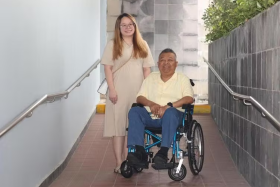'It was my calling,' says Singapore nurse who joined fight against Ebola in Africa
Even the real risk of contracting the deadly Ebola virus did not keep nurse Wong Li Wai, 38, from leaving for Sierra Leone in West Africa.
Ms Wong was there last November during the outbreak. The sight of blood and death all around here did not put her off.
Instead, she focused on helping to get survivors out of the Ebola Management Centre.
She said: "When we see survivors walking out of the centre, it's like looking at a miracle. All the staff will stop what they were doing at the moment and celebrate for the survivor because it's such a great feeling."
Ms Wong had been working at the Institute of Mental Health for three years when she read about the medical humanitarian organisation Doctors Without Borders.
She became interested in their overseas missions and decided that humanitarian work was her calling.
In 2012, she went on a mission to Zambia, in southern Africa, for six months as a field nurse, working with HIV patients. Soon after, she left for her second mission to the Doctors Without Borders hospital in Lankien, South Sudan, for nine months.
She then joined non-governmental organisation Action for Aids, but left after six months when she read about the Ebola outbreak in Africa.
By then, Doctors Without Borders had sent e-mails and messages, calling for manpower.
There was a shortage because each volunteer could help for a period of only five weeks, in order to keep them well rested. Doing so lowers the likelihood of them getting infected.
"It was my calling to help," Ms Wong said. She packed up and left last November, making her way to the Ebola Management Centre in Sierra Leone's Bo town with other missioners.
'WHAT IF I DIE?'
Ms Wong said: "Upon arriving, my first thought was that I don't have to worry, I am not alone.
"But of course, the thought of contracting Ebola ran through my mind... Like, what if I become the first Singaporean infected with the Ebola virus and what if I die?"
But she said she had confidence in Doctors Without Borders' safety protocol. She had to put on a full suit of personal protection equipment twice a day to go into a tent full of Ebola patients to clean, feed, and give them medicine.
She said: "People were very vulnerable... Some of them looked well and very alive the day before, but would fall very ill and die the next day.
"The other half of them would enter looking very ill, but end up surviving and walking out of the centre."
During those five weeks, her parents had no knowledge that she was in West Africa.
Ms Wong said: "I didn't want to create unnecessary worry for them... I didn't want to be distracted from going on this mission."
Her parents found out only after she returned in February this year.
A month later, she went back to Sierra Leone with the group and spent two months educating villagers on Ebola prevention.
She is now back in Singapore and will be sharing her experience at the Doctors Without Borders' photo exhibition "Witnessing the World" on Nov 7.
"It has been a very fruitful experience and this is something I will remember forever," she said.
EBOLA FACTS & STATS
1 The Ebola outbreak in West Africa was first reported in March 2014 and rapidly became the deadliest occurrence of the disease since its discovery in 1976.
The current epidemic has killed five times more than all other known Ebola outbreaks combined.
2 More than 18 months after the first confirmed case was recorded on March 23, 2014, at least 11,312 people are reported to have died from the disease in six countries: Liberia, Guinea, Sierra Leone, Nigeria, the United States and Mali.
3 The total number of reported cases is more than 28,457.
4 The World Health Organisation (WHO) calls it "one of the most virulent diseases known to humankind".
5 It can kill up to 90 per cent of the people who are infected. Five "species" of Ebola have been identified and have been named Bundibugyo, Sudan, Zaire, Tai Forest and Reston. The first three are particularly lethal, with fatality rates of up to 90 per cent.
6 Ebola can be caught from both humans and animals. It is transmitted through close contact with blood, secretions, or other bodily fluids. Fruit bats are considered to be the natural host of the Ebola virus.
WHAT IS EBOLA?
1 It spreads in the blood and paralyses the immune system.
2 Ebola is often characterised by the sudden onset of fever, intense weakness, muscle pain, headache, and sore throat. This is followed by vomiting, diarrhoea, rash, impaired kidney and liver function. In some cases, there is both internal and external bleeding such as from the nose or via a person's urine.
3 Symptoms can appear from two to 21 days after exposure and the virus can be hard to diagnose in the early stages.
Event info
Doctors Without Borders will hold its first public event in Singapore.
The "Witnessing the World" Photo Exhibition runs from today to Sunday.
The exhibition will display images captured by some of the world's renowned photographers, who looked at the work of the international organisation.
They covers major humanitarian crises such as the Ebola outbreak in West Africa and conflicts in areas such as Syria and Gaza.
WHAT: Witnessing the World photo exhibition by Doctors Without Borders/ Medecins Sans Frontieres (MSF)
WHEN: Now until Sunday, 10am to 10pm
WHERE: VivoCity, East Court A, Level 1
ADMISSION: Free
Get The New Paper on your phone with the free TNP app. Download from the Apple App Store or Google Play Store now



